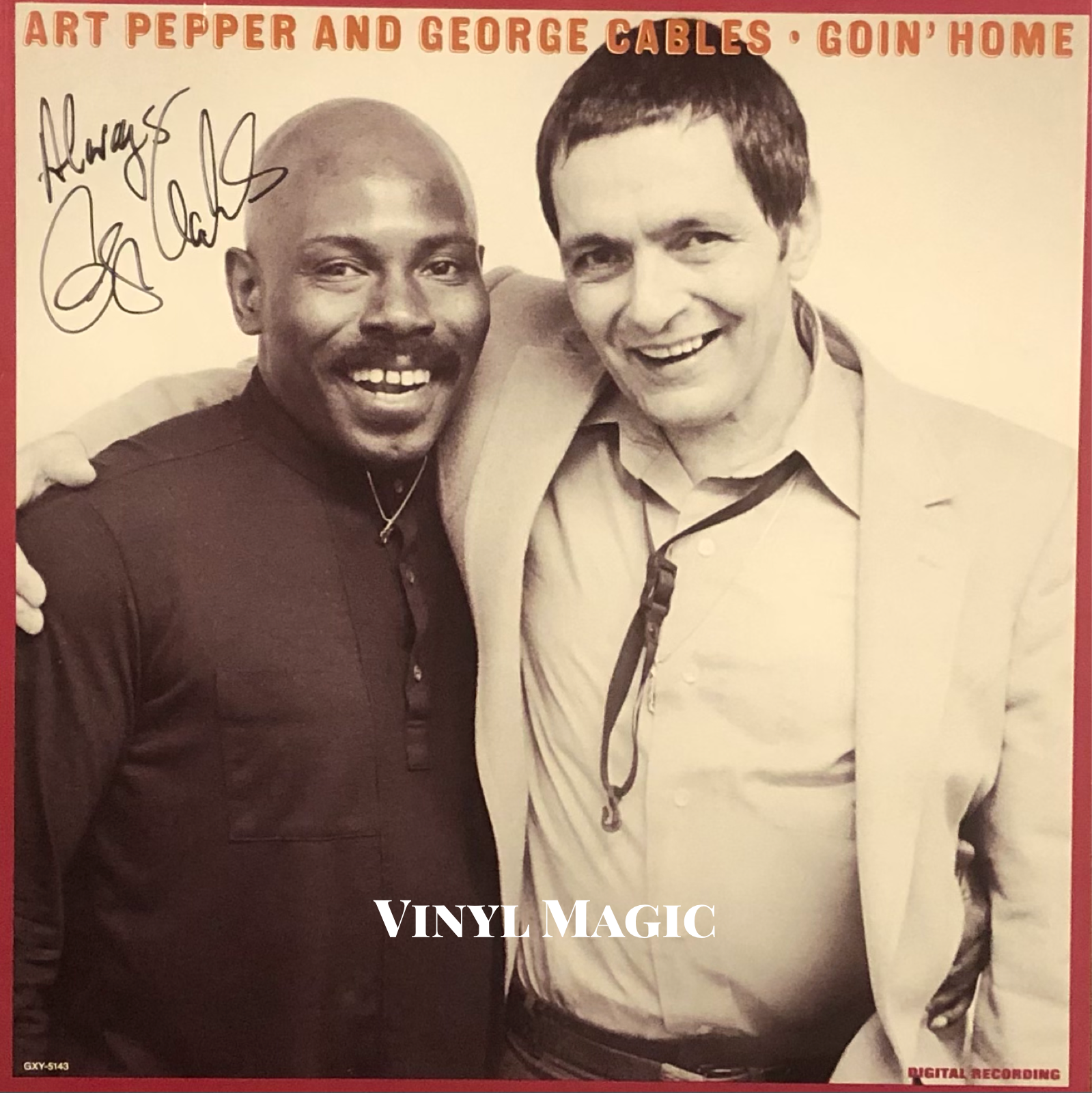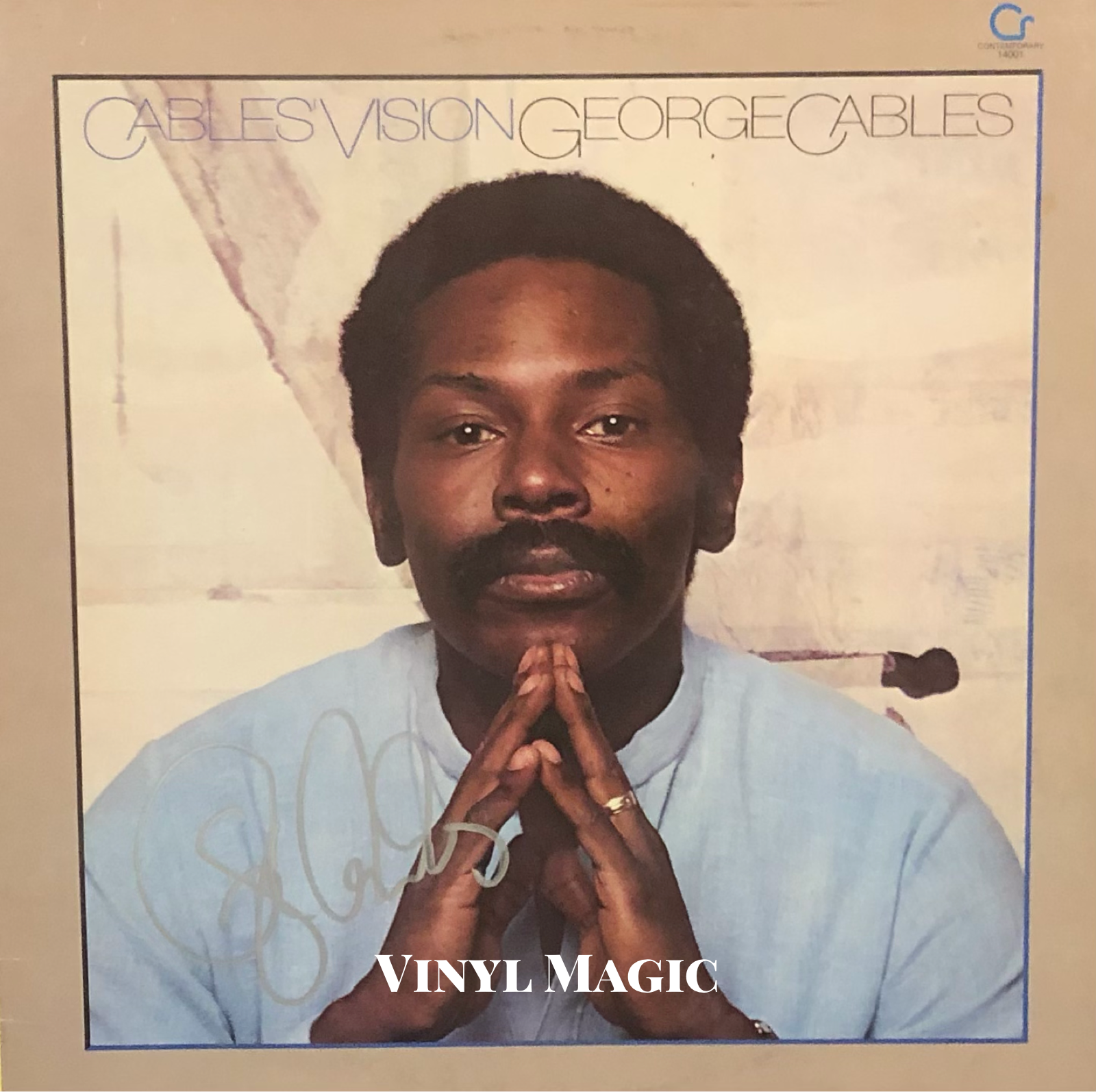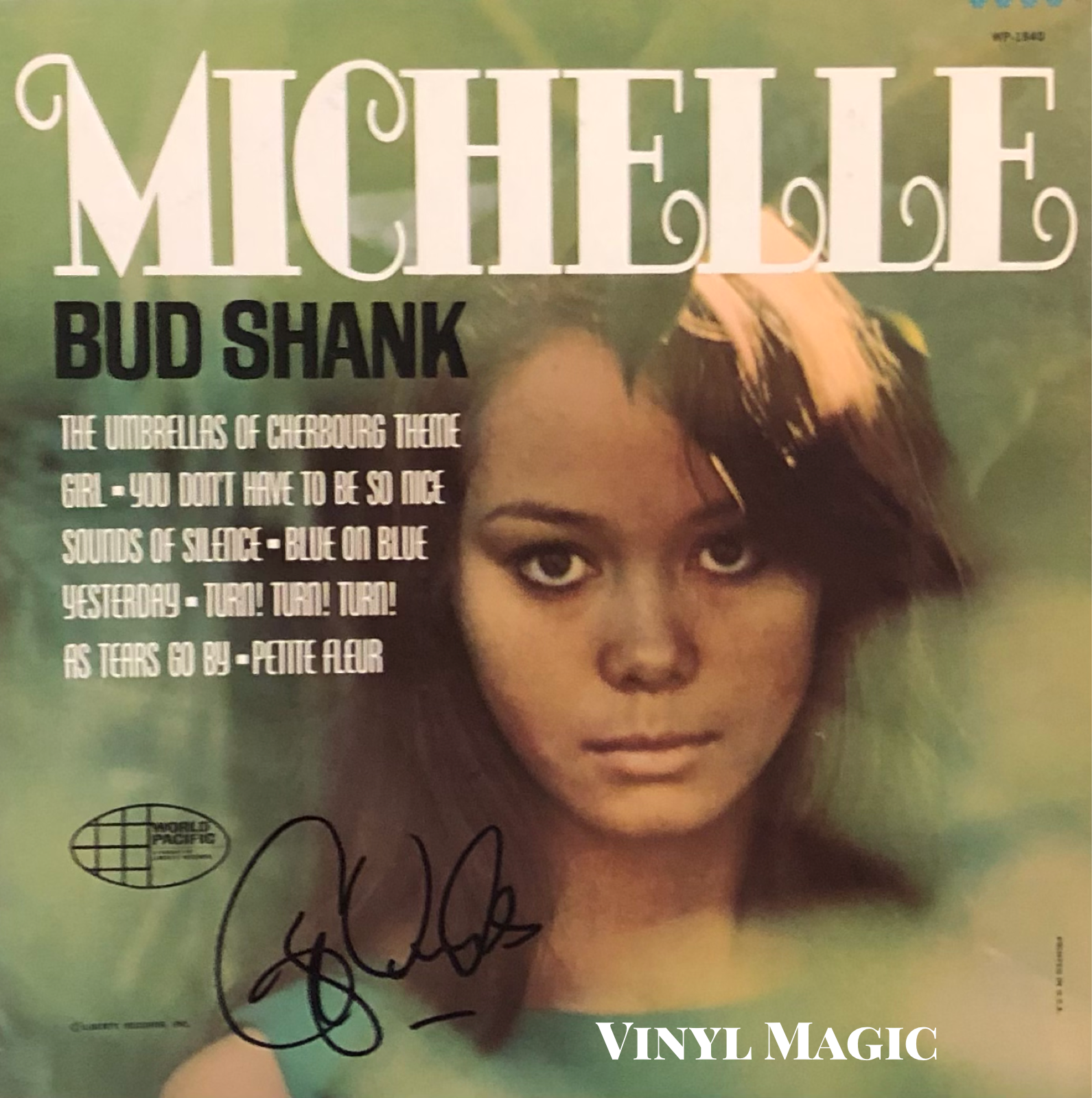George Cables, Art Pepper and Me…
I don’t feel that one should be stuck in the mud playing the same old stuff all the time, trying to prove that this music is valid. We don’t need to prove anything, but I think you really have to be responsive to your heritage and then go on and find your own voice.
George Cables
Goin’ Home (1982) signed by George Cables
I never really listened to pianists when I was coming up. I would probably say I’ve been more influenced by Miles or Trane and their whole bands rather than by any single pianist. The concept of the music is more important than listening to somebody’s chops, somebody’s technique, The way Miles’ band held together, it was just like magic. You were transported to another world.
George Cables
Circle (1979) signed by George, Rufus Reid
The Jazz Samaritans was led by Artie Simmons…and his cousin was Roy Haynes who would come by and check us out, especially if Billy was playing, he wanted to check out Billy Cobham. He would also sit in, play the drums. I mean, I wasn’t really playing anything, I was just starting, didn’t really know anything, but he would come and thrill us. I remember Roy Haynes did a roll on the bass drum, and everybody just fell out! He took a solo on the bass drum, we couldn’t believe it, we didn't know anyone’s foot was that fast! I thought it was just great, and later I got to play with him, which was even better! Once I was playing with him, and I was enamored at that time with the rhythm section Miles had with Herbie, Ron, and Tony, you know, they used to catch each other and play across the bar, play these accents. So I thought, you know, since Roy, when he would accent, it wasn’t like he would always come down on “one,” or the “four.” But I would try to catch him, but it was trying to chase him around the block, you never could pin him down! So he said “George…” He gave me a very nice lesson, and told me in a very nice way, he didn’t say, “Hey man, stop doing that, don’t do that,” he said, “Do you know who I listen to?” I said, ‘No.’ He said, “I listen to the piano player.” So he’s telling me, ‘Look, you could just do your thing and I can follow you, or I can be free to do my thing too, and that’s how it will come together.’
George Cables on his first band and early lessons from Jazz master Roy Haynes
Phantom Of The City (1985) signed by George
Yeah, that was the last session. Tete-a-Tete and Goin’ Home were the same session. We didn’t know it at the time when we were doing it that it would be Art’s last. I chose that song “Goin‘ Home,” I was going to dedicate it to my mother-in-law who passed, but then Art passed away, so it became the idea of Art “Goin’ Home,” and that became the title of the record. And then the other one, “Tete-a-Tete” was a kind of calypso I wrote. I remember one thing, on the first session Art was nervous about doing it duo, and (producer) Ed Michel kept going and coming back in, so we locked the door. Course, Ed just found the key and came back! But Art just didn’t wait, he said, “Come on man, I just want to do this.” But Ed was being a producer, you know, gotta do this, gotta do that. Duo was a new thing for both of us, we wanted to get it right.
George Cables on his last recordings with Art Pepper
Tete A Tete (1982) signed by George
I saw Trane at age 20 at Birdland, with Elvin and McCoy Tyner and Jimmy Garrison, what a band. But I was really still too young to really get the most out of that music, I was too young musically, not musically initiated enough to really get it. I heard some things where I was really moved, but I didn’t really know and understand in my heart and in my soul exactly. I didn’t understand in a deep way what was going on. I got some of the things, as much as I could at the time. I got to Trane a little later on. That was when I was listening to some music in the basement and I was on the phone. I had A Love Supreme on—it was like something that was pounding on the door, you know, pounding on my brain’s door, “Let me in!” I got so distracted, I couldn’t talk on the phone, I had to hang up. All of a sudden, it was this epiphany, this realization, boom: “Oh, I get it.” You hear the stuff before, and you kind of like it, but everything else is kind of on the surface for me.
George Cables on the transcendence of John Coltrane
Cables’ Vision (1979) signed by George
That was right in your face with McCoy, because of the kind of music he was playing. McCoy was playing with Elvin for chrissakes, so he’s playing the piano more like a drum, and the left hand was very strong. His right hand was very strong, and McCoy is very soulful too, but you felt as if he was playing percussively, not that he was banging, but his was a percussive approach that the piano was a percussion instrument like the vibes, or an African xylophone. Herbie, I thought, was a little more lyrical, and would use colors. Someone asked Freddie (Hubbard), “Who do you like better, Herbie or McCoy?” And Freddie, I don’t know if I’m quoting him right, but he said, “Well, McCoy’s my man, but Herbie can do anything!”
I mean Herbie’s voicings, I don’t know! Sometimes I asked Herbie, “What are you playing?” He said, “I don’t know.” Just put the piano in front of you, and where your hands fall, your hands fall. What he played was, I think, harmonically complicated. McCoy, you know, you got the sense that McCoy could kind of manhandle this thing. The feeling from McCoy… I remember one night at Keystone Korner in particular, I would have sworn that that piano was being levitated, he played with so much energy, it would just pick you up.
George Cables on Herbie Hancock vs. McCoy Tyner - Who ya got?!
Landscape (1979) signed by George
I try to tell students that the piano is a percussive instrument, and it can sing if you make it sing, and the whole orchestra’s in there, but you strike it, and that’s a quality, when you comp, I think you need to take advantage of. Some guys, you just hear the chords, a chord here, a chord there, but you need to invest in the rhythm, whether you’re delicate, it doesn’t mean you need to pound everything. You can try to drive and be an engine for a band, that’s part of what you do. The pianist, you know, we’re glue. We’re the glue of the rhythm section in a way, and maybe sometimes the glue in the band.
George Cables
High Energy (1974) signed by George, Freddie Hubbard
A sideman's sideman, George Cables has forged an exemplary career as an arranger, composer, and pianist. A leader or co-leader on more than forty albums, George has also appeared on hundreds of sessions with jazz luminaries Dizzy Gillespie, Dexter Gordon, Roy Haynes, Joe Henderson, Freddie Hubbard, Bobby Hutcherson, Max Roach and Sonny Rollins. His deft lyricism and acute sense of swing always bolsters and enhances these artists' recordings. George may be best known for his collaborations with Art Pepper at the end of Art's troubled life, and he appeared on more than twenty Art Pepper recordings, most released posthumously. Art's wife, Laurie confided that George was Art's favorite pianist, and as evidence, Art nicknamed George “Mr. Beautiful." He wasn’t lying, Art knowed!
Born in New York City in 1944, George was classically trained and attended the prestigious High School of Music & Art in Hamilton Heights in Harlem. Some very notable alumni are actor/singer/ Diahann Carroll, designer Milton Glaser, singer/songwriter Laura Nyro, KISS frontman Paul Stanley and actor Billy Dee Williams, quite an eclectic collection of artists. It also includes drummer extraordinaire Billy Cobham.
Crankin’ (1971) signed by George, Curtis Fuller, Lenny White, Stanley Clarke
A relatively late bloomer in jazz, George recalled in a wonderful recent interview with pianist Ethan Iverson, "I started playing piano when I was about six or so. Before then, actually, I used to watch my mother play in the house, and I used to try to reach up to the piano to play. The music that I'm involved with now, Jazz, was not in my vocabulary, It wasn't in the house. I remember people I played with saying, 'Yeah, man when I was a kid, I used to listen to my grandma, my father's records. I was listening to Bird when I was eight or thirteen, or something.' But all this stuff was new to me when I was fifteen or seventeen years old, so I was playing catch-up a lot of the time."
When he graduated from high school, George attended The Mannes School Of Music as a piano major and he joined his first band, The Jazz Samaritans, led by drummer and trombonist Artie Simmons. Other members were saxophonist Steve Grossman, bassist Clint Houston, Billy Cobham and Lenny White, all eventual jazz band leaders and stalwart musicians. George's real education was just beginning, and it started at the Five Spot, a venerable and storied New York City club, where he saw Thelonious Monk, Charles Mingus, Coleman Hawkins' big band and others perform their illustrious magic. Soon, George was invited to play sessions with Art Blakey (he was a Jazz Messenger for a short stint in 1969), Frank Foster, Woody Shaw and Max Roach.
Double Image (1986) signed by George, Frank Morgan “Duet To It!”
George remembered his time with Max fondly, "We played different places with Max, because he was very business-like, he paid well. He had another air about him, and one night, Thelonious Monk came out to hang out at Club Baron, I couldn't believe it! We got off the stand and he kept looking at me. You know, I'm not one to go up to Thelonious and go, 'Hello Mister Monk!" All I know is that he's a different kind of guy. He's Thelonious Monk, he's someone apart from everybody. I might say something to Max (Roach), but who knows what to say to Thelonious Monk? And that night we had a party at Max's house, and Monk was there, and the night after, Max said, 'You know, that's the most I've heard Monk say in years.' And I hadn't heard him say anything that night! And Max said, 'You know, he likes you,' and man, I haven't come down from that yet."
Artworks (1979) signed by George
His chops sufficiently strengthened, George embarked on a tour with Sonny Rollins in 1969 which landed him in California. Smitten with the lifestyle and the West Coast music, George settled there for decades, initially in Los Angeles, then in San Francisco, finding session work with Freddie Hubbard, Joe Henderson, Art Pepper and other California compatriots. He also began recording at Contemporary Records, an influential Los Angeles based record label founded by Les Koenig in 1951.
Koenig was a Hollywood screenwriter and producer who was swept up in the furor fomented by the ugliest American Joseph McCarthy in his dogged pursuit of communists (real and mostly imagined) in the 1940s-50s. Though Koenig was not a communist, he was asked to testify and name "names." Rather than do that, as some disgracefully did, he accepted his blacklist as a punishment and started a record company. Motion pictures‘ loss was clearly music’s gain. Initially, Koenig wanted to record his friends - composers from the film community - but he broadened the label to indulge his passion for jazz.
Dynamics (1985) signed by George
While not as revered or acclaimed as the Blue Note label in New York City, Contemporary Records in Los Angeles was responsible for some epochal recordings: Sonny Rollins' Way Out West, Cecil Taylor's Looking Ahead!, Art Pepper Meets The Rhythm Section and Andre Previn's Double Play! Probably the most controversial and important recordings were Ornette Coleman's Something Else!!! and Tomorrow Is The Question! although the engineer, Roy DuNann, begged to differ. Upon hearing Ornette’s challenging rhythms and dissonance, Roy quipped, “I would have sent them home.” Although Ornette Coleman is considered a visionary now, his music mostly eluded Roy, “Yeah, I got so I could listen to a lot of the jazz stuff and know where one chorus was going to end and the next one begin. It was important for knowing where to make a splice. But with Ornette, you couldn’t tell where you were. It just started out and it ended. It wasn’t music at all for me.”
Art Lives (1983) signed by George, David Williams
Though Roy was less well known than Blue Note engineer supreme Rudy Van Gelder, he was vastly talented and a secret weapon at Contemporary Records. Roy was recruited to join Contemporary from Capitol Records, having worked on Nat King Cole, Peggy Lee, Dean Martin, Frank Sinatra, and hundreds of other sessions. With his keen ear and extensive experience, Roy helped design the recording studio, “Lester decided he wanted to try recording jazz groups in the shipping room. There were records stacked all over the place on record shelves. We needed a little control room so we could listen on loudspeakers without feedback into the studio, so we set it up in the office across from the publicist’s. Lester had a German friend who had worked at Telefunken with an engineer named Neumann. This friend had brought a Telefunken condenser microphone with him from Germany.” The magic would continue until Les Koenig's unfortunate and untimely death in 1977, and Roy’s departure from the recording studio.
That Old Feeling (1986) signed by George
Erin and I have been very blessed to see George Cables perform dozens of times over the years and it is always a joyous occasion. Full of impossibly good cheer, George's spirit radiates in his wonderful playing. There have been so many memorable shows over the years, at Blues Alley in Washington, DC, the Blue Note in New York City, and Bradley's, a now shuttered and sorely missed jazz club in the West Village. Erin and I have also seen George numerous times at the Jazz Forum in Tarrytown, New York, a wonderful jazz club run by trumpeter Mark Morganelli and his lovely wife Ellen.
Keep Your Soul Together (1973) signed by George, Freddie Hubbard, Ron Carter
After a recent Jazz Forum show, where George was supporting a record release by guitarist Roni Ben-Hur, George was warm and welcoming, and he was happy to sign some vinyl. I asked George how he ended up paired with Art Pepper on so many great recordings? "Thank you," he replied, "I was doing some sessions with Woody Shaw at Contemporary (Records) and Les (Koenig) really liked my sound and he thought Art and I would sound great together." And Les, with his impeccable taste was right! George was particularly struck when I handed him Freddie Hubbard's Keep Your Soul Together. He opened the gatefold carefully and pointed at a photo of saxophonist Junior Cook, "You know, Junior was my roommate, we lived together for awhile. What a great man and musician, I miss him." Erin and I thanked George for his time and, especially his music.
George Cables, a remarkable and remarkably unsung musician, the glue in every band and "Mr. Beautiful" in all ways possible. Long may he play!
California Concert (1985) signed by George
Choice George Cables Cuts (per BK's request)
https://www.youtube.com/watch?v=rafXSARZtSw
“Over The Rainbow” duo with Art Pepper 1982
https://www.youtube.com/watch?v=UQ8m-fYpfMA
“Over The Rainbow” live with Art Pepper 1981
https://www.youtube.com/watch?v=_cyyKadNqV0
“Arthur’s Blues” live with Art Pepper 1981
https://www.youtube.com/watch?v=LBdpHfZmlMc
“In A Sentimental Mood” George plays Duke Ellington! 1995
https://www.youtube.com/watch?v=WgaFAmToHRE
“It Don’t Mean A Thing” more Duke Ellington, live at Keystone Korner 2020
https://www.youtube.com/watch?v=OTCVkNawNa0
“Don’t Let The Sun Catch You Crying” with Art Pepper 1982
https://www.youtube.com/watch?v=LKm__ke__BY
“Keep Your Soul Together” with Freddie Hubbard, Ron Carter, Junior Cook 1973
https://www.youtube.com/watch?v=d4GVyzHdjgI
“For All We Know” Too Close For Comfort 2021
https://www.youtube.com/watch?v=59ntu1ZlzQc
“Lullaby” My Muse 2019
https://www.youtube.com/watch?v=nHBA6Ee5htc
“Isn’t She Lovely?” Goin’ Home Art and George slay Stevie! 1982
Michelle (1966) signed by George
Thank You Thank You (1977) signed by George, Roy Haynes
Some Of My Favorite Things (1980) signed by George

















